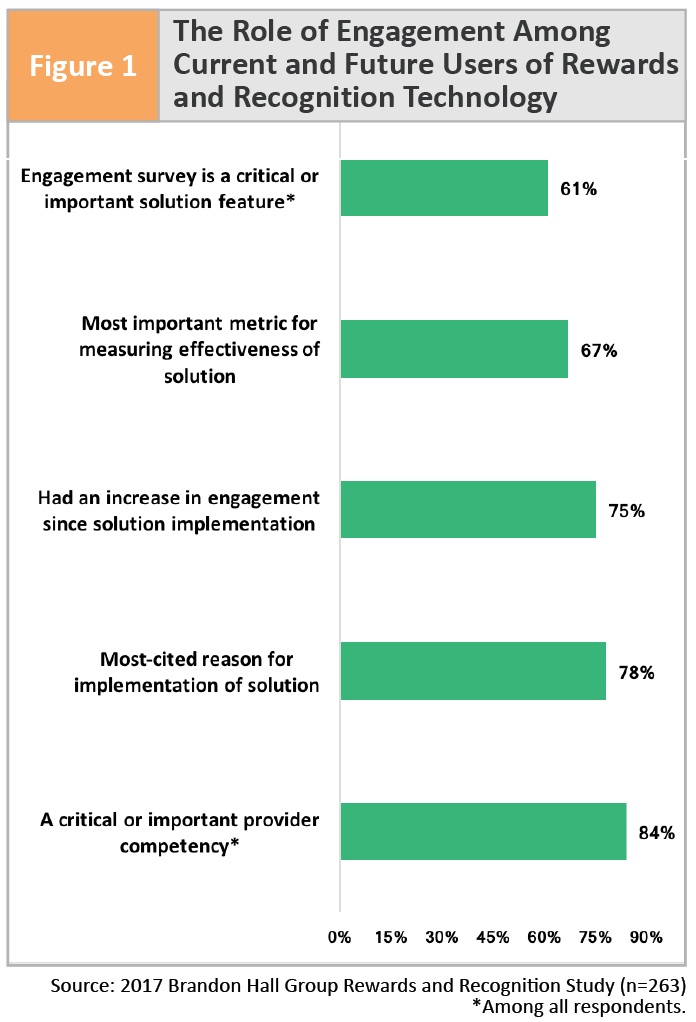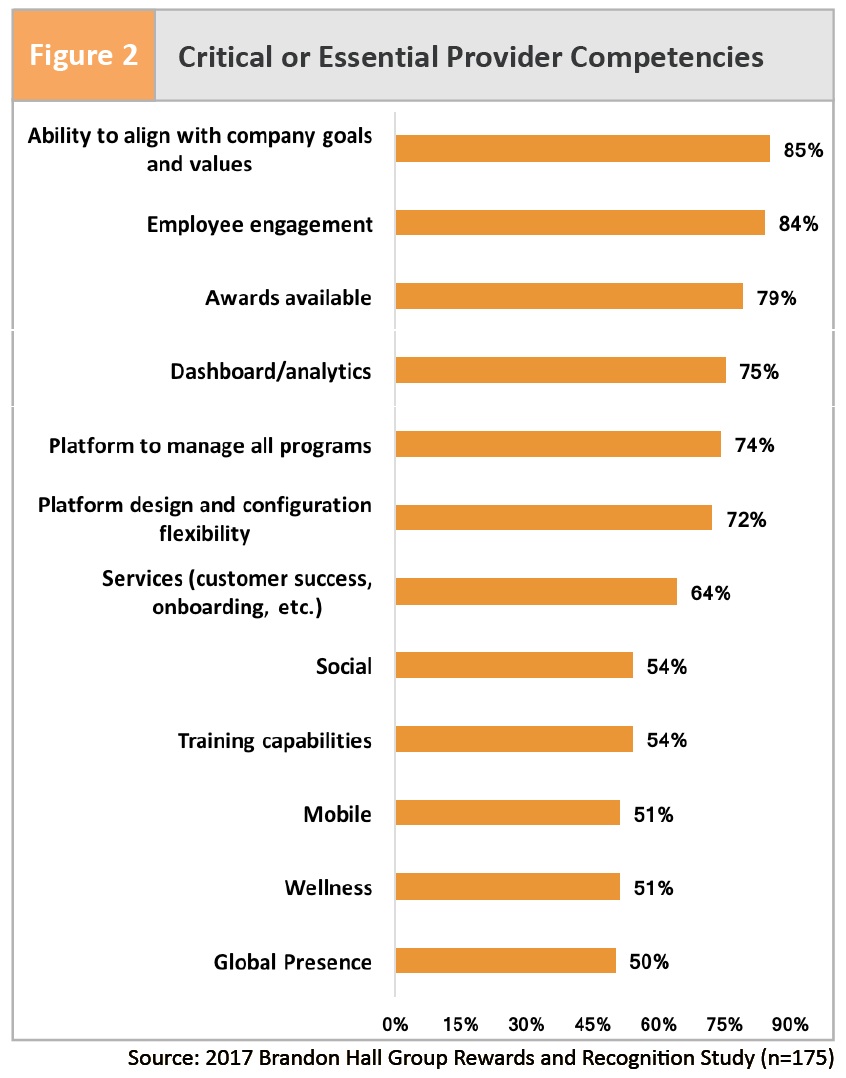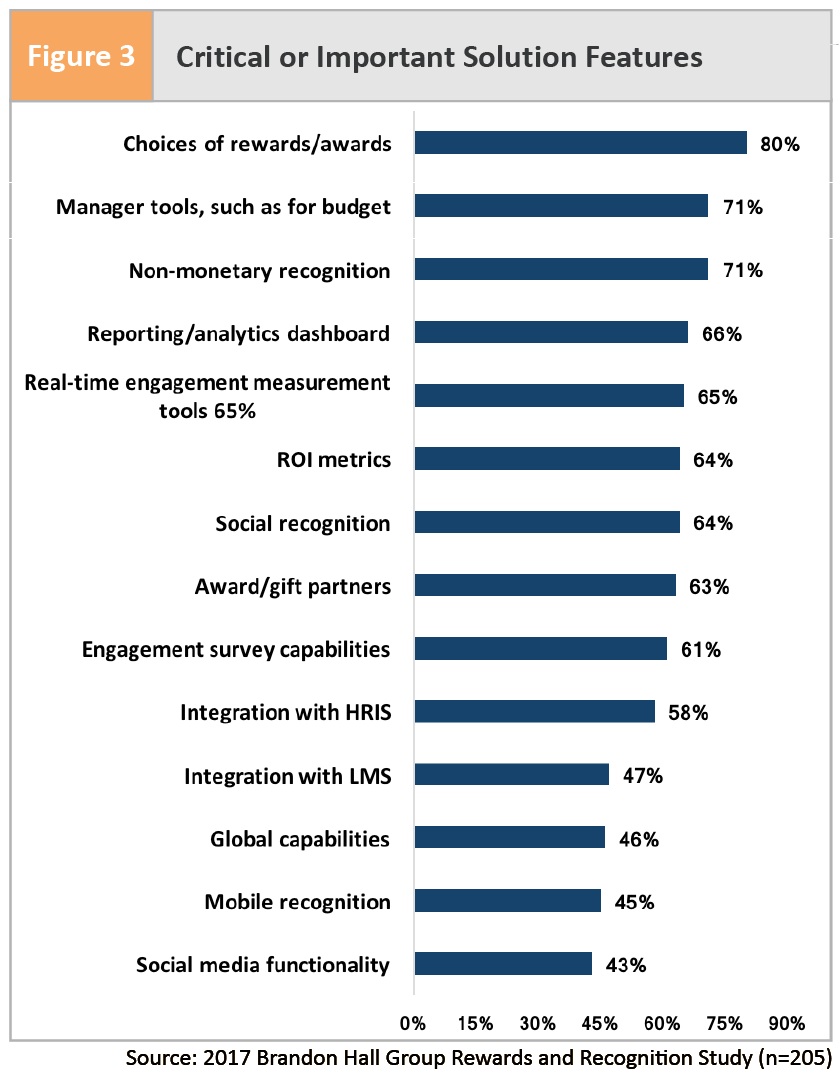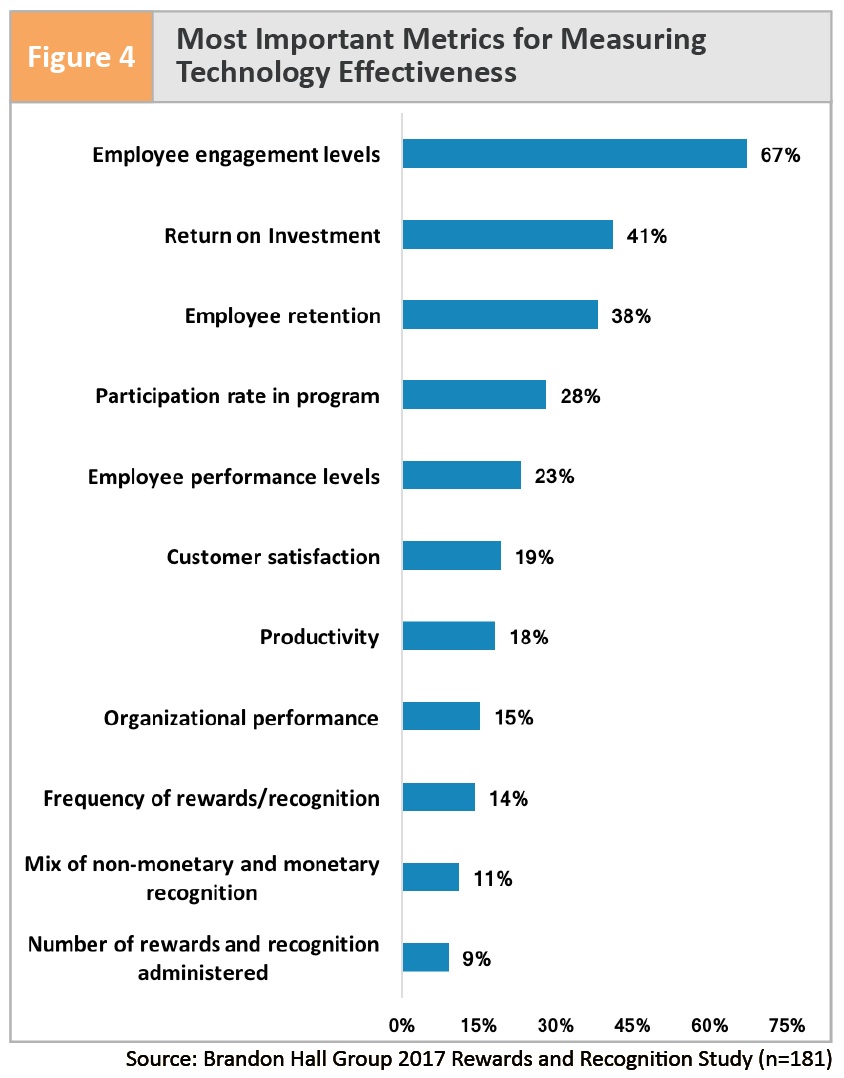
Rewards and recognition technology solutions play a significant role in how organizations manage their workforce. Viewed as a way to engage employees, enhance the organizational culture, and improve organizational performance, these solutions are being used by more than half (56 percent) of all the organizations surveyed, but predominantly by high-performing (68 percent) and enterprise (72 percent) organizations (10,000-plus employees), according to Brandon Hall Group research. High-performing organizations (HiPOs) are shown through survey results to see overall improvement across these criteria: employee engagement, customer satisfaction, organizational revenue/performance, voluntary turnover, and organizational productivity. An average of nearly 7 percent of an organization’s talent management/HR budget is dedicated to rewards and recognition, and nearly 32 percent of organizations expect that budget to increase.
Our research shows that a substantial percentage of organizations have already seen an improvement in their key performance indicators since implementation of their rewards and recognition solution. Current users of a rewards and recognition technology solution have seen an increase in:
- Employee engagement (75 percent)
- Productivity (61 percent)
- Employee retention (46 percent)
- Revenue (33 percent).
While the solution may not be the only reason engagement and productivity increased, it greatly contributes to those metrics.

In terms of best practices, there are some differences in the types of rewards given for length of service and performance. Many organizations provide a monetary reward, such as a gift card (67 percent), for performance, while a symbolic award (41 percent) typically is given for length of service. In-person is the main way organizations reward (71 percent) and recognize (62 percent) their employees.
Analysis of Top Findings
1. Use of technology is heaviest among HiPOs and large organizations. Overall, more than half of organizations use an in-house or third-party rewards and recognition technology solution. Another 15 percent plan to invest or develop one in the next two years. However, when looking at high-performing organizations (HiPOs), current use climbs to about two-thirds (68 percent). Additionally, a greater percentage of enterprise organizations (72 percent) than mid-size (1,000 to 9,999 employees) (63 percent) and small (less than 1,000 employees) (41 percent) currently use an in-house or third-party solution.
2. Employee engagement, appreciation, and culture drive technology use. The impact HCM technology is having on employee engagement and culture now is being understood to a greater degree by organizations. Proof of that can be seen by the current and potential adoption of rewards and recognition technology solutions.
The most often-cited reasons organizations implement, or plan to implement, rewards and recognition technology are to improve engagement (78 percent), show appreciation (77 percent), and improve or enhance the culture (70 percent). These results are fairly consistent across the different organizational segments.
Among those organizations not using and not planning to use/develop a rewards and recognition technology solution, the primary reason is budget (44 percent). Other contributing reasons are lack of leadership buy-in (33 percent), having too few employees (23 percent), not being familiar with the technology solutions (21 percent), and having trouble developing a business case (8 percent).
3. Technology has a strong positive impact on business metrics. The majority of organizations indicate that since implementation of their rewards and recognition technology solution (either in-house or third-party), they have seen an increase in employee engagement and productivity levels. Nearly half have seen an increase in employee retention, and about one-third report an increase in revenue. These results are not to say that only a rewards and recognition technology solution caused an increase in business outcomes, but the solution has definitively contributed to the increase in organizational performance. Notably, few organizations said there was a decrease in any of their business metrics since implementation of the solution.
Interestingly, a substantial percentage of the organizations responding to the survey were unable to answer the business impact question. The explanation for the high number of “don’t know” responses could relate in part to the fact that many organizations are not really tracking their rewards and recognition efforts and they are not relating those efforts to their business outcomes.
4. Technology buyers want providers aligned with their goals and values. When selecting a rewards and recognition technology solution, buying organizations most covet a provider’s ability to align with company goals and values and the ability to focus on employee engagement. More than 70 percent of organizations also believe these competences are critical:
- The types of available awards
- Dashboards and analytics
- A platform to manage all programs
- Platform design and configuration flexibility
Organizations of all sizes believe these competencies will help make the business case to purchase the technology and will facilitate the administration and use of the solution.
There were some distinct differences in some priorities based on company size. For example, as expected, a greater percentage of enterprise organizations than small and mid-size organizations believe it’s critical/important for the provider to have a global presence (63 percent vs. 42 percent for small and 50 percent for mid-size organizations). A larger percentage of small organizations than mid-size and enterprise organizations said wellness competencies are important or critical (57 percent for small organizations vs. 43 percent enterprise and 46 percent mid-size).

At least 7 in 10 organizations consider these technology features to be critical or important to their choice of a recognition and rewards solution: choice of rewards/awards, non-monetary recognition, and manager tools for budget.
A greater percentage of enterprise organizations said integration with a human resource information system (HRIS) is critical or important (68 percent enterprise vs. 56 percent mid-size and 53 percent small organizations). Mid-size organizations are more likely to want manager tools for budget (80 percent vs. 68 percent enterprise and 65 percent small organizations), and social recognition tools (75 percent mid-size vs. 56 percent enterprise and 60 percent small organizations).

5. Monetary rewards usually are provided for performance, while symbolic awards/jewelry mainly are given for length of service. There are some differences in the way organizations reward their employees for the length of service and performance. Non-monetary rewards seem to be used by about two-fifths of the organizations for length of service, with the most-cited rewards being symbolic such as pins/jewelry and merchandise. Gift cards are used by two-thirds of organizations to reward individual employees for performance.
A possible explanation for the emphasis on monetary rewards for performance is that it may be easier to motivate performance on a short-term basis to achieve a performance goal with a gift card—which may be more needed and easy to use. Length of service involves a much longer time frame and the significance of that time is best expressed with a symbolic award that can evoke the memory of the employment experience and appreciation for that service.
Administration
The majority of organizations recognize and/or reward their employees in person. The second most selected way to reward employees is at an event. Organizations tend not to use e-mail to reward employees.
When considering how to recognize and reward employees, organizations also should take into account employee preferences and their own culture. Some employees may prefer not to be recognized in a group, while others appreciate public recognition.
Most Important Metrics
Two-thirds of the organizations responding to our survey consider employee engagement to be the most important metric for measuring the effectiveness of their rewards and recognition solution. Approximately two-fifths also consider return on investment and employee retention to be important metrics. These results are consistent by organizational size and by performance level (high-performance vs. all other organizations). It makes sense that these three metrics are considered most important because research has shown that they drive business performance.

Daria Friedman is principal analyst for talent acquisition for Brandon Hall Group, an independent research and analyst firm covering all aspects of human capital management—learning and development, talent management, talent acquisition, leadership development and workforce management/HR. The company also produces the Brandon Hall Group Excellence Awards, which are open for applications through April 21, and the annual Excellence Conference.




